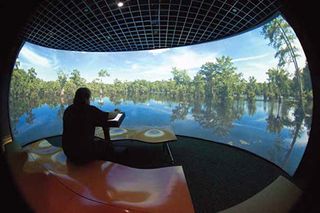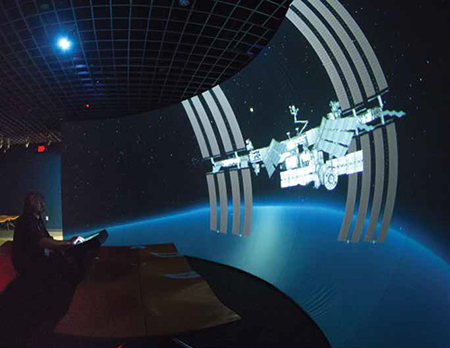Digital Projection’s dVision 35 projector displays images onto the 23-foot wide Elumenati OpenDome screen at the Science Panorama exhibit. Science fiction writer Arthur C. Clark observed that, “any sufficiently advanced technology is indistinguishable from magic.” At the Nature Research Center at the North Carolina Museum of Natural Sciences (NCMNS) in Raleigh, NC, immersive exhibits provide this jaw-dropping experience that Clark could only have dreamed of 25 years ago.
Recently, Milwaukee-based immersive projection design company, The Elumenati, stepped in to design and deploy the Science Panorama exhibit at NCMNS, an immersive, interactive theater that projects high-resolution video content, enabling visitors to “explore the solar system using real NASA mission data, and then come back to Earth to learn about ecosystems and natural beauty unique to North Carolina,” explained Hilary McVicker, vice president of sales and marketing at The Elumenati. The Elumenati has created custom installations for a range of artistic, commercial and educational clients, including NASA, NOAA, and leading science centers around the globe.
A 23-foot wide Elumenati OpenDome panoramic screen sets the stage for the Science Panorama at the NCMNS Nature Research Center. “A single projector in the ceiling uses our OmniFocus fisheye lens, so you walk in and are surrounded by dynamic and compelling imagery, and you don’t really see where it’s coming from,” said McVicker. This unobtrusive technology contributes to the sense of immersion, and it’s highly efficient compared to the multi-projector solutions often used to fill a screen this size.
Elumenati chose Digital Projection’s (DP) dVision 35, 3-chip, WQXGA, DLP projector for the museum installation. “With the WQXGA projection system, we were able to use a single-channel projection system and put almost as many pixels on the screen as a similar installation using multiple projectors,” McVicker said.
“Our design philosophy leans towards simplicity, creating systems that are both elegant and efficient,” she continued. “Using a fisheye lens has a lot of practical and pragmatic benefits over multiple projectors,” among them, eliminating edge-blending, calibration between projection channels, and creating multiple content channels. This simplifies content creation, and the overall system is easier to maintain.
The Panorama has a fabric screen over a metal frame, using Elumenati’s patented negative-pressure technology. A small fan at the back of the dome sucks the screen tight against the structure of the dome. It’s a semi-permanent solution, as opposed to its portable inflatable domes, or permanent domes using perforated aluminum or curved drywall.
A 2.1 audio system is located behind the screen. “Audio is a very important part of the immersive experience,” said McVicker. “It really creates the tone of the environment and sets the mood, which adds an emotional impact to Earth and space science education.”

The exhibit’s “Earth As Art” looks at images from LANDSAT’s 40 years of Earth observation at the North Carolina Museum of Natural Sciences. The Elumenati team collaborated with the museum on content, providing a combination of software tools to deliver the experience. From the interactive touchscreen kiosk located in front of the 23-foot panorama, Elumenati’s WorldViewer enables museum visitors to understand global processes and then explore their local impacts. At NCMNS, one interactive story looks at hurricanes from the global perspective using a movie created by the American Museum of Natural History, then stitches together photos from the North Carolina State Archives to show the impacts of historical hurricanes on the state. Another story, “Earth As Art,” looks at images from LANDSAT’s 40 years of Earth observation.
Elumenati’s WorldComposer is the authoring tool used to make data-based content interactive. “It’s like a media mash up tool. It lets you use a ton of existing spherical data from sources like NASA and the National Oceanic and Atmospheric Administration (NOAA) to look at datasets on an interactive, virtual globe, and then geo-locate pieces of content around the globe that you can zoom into and explore,” McVicker said.
The high resolution, coupled with good color and contrast, delivered by a single, DP dVision 35 projector combined with the Elumenati 500 series fisheye lens, McVicker said, “was really helpful to us to create a single-channel fisheye system with beautiful image quality.” And that’s only getting better. Elumenati looks forward to using DP’s new 4K Insight Laser projector. “This is going to enable us to put really high-resolution images in single-channel installations, and fill even larger domes and panoramas with our multi-projector fisheye systems. They’ve [DP] continued to be open to engineering collaborations, allowing us to build projection systems with optimal image quality.”
Technology enables science education. “What we often say about the power of immersive and interactive environments in science education is that you go from the ‘wow factor’ to the ‘AHA factor.’ They’re not just very cool and attention-grabbing, they’re also very effective teaching tools. Visitors walk away with a exciting and memorable learning experience,” said McVicker.
Kelleigh Welch is managing editor of SCN. Follow her on Twitter @kelleighwelch.










